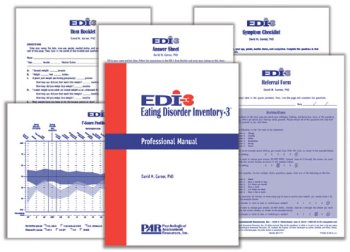 | ||

This revision of the widely used EDI-2 measures psychological traits associated with eating disorders. Like its predecessor, the EDI-3 provides objective scores and profiles that are useful in treating individuals with confirmed or suspected eating disorders. Administered in just 20 minutes to individuals or groups, this self-report inventory is also useful in assessing areas of psychopathology, identifying meaningful patient subgroups, and assessing treatment outcome.
The inventory consists of 91 items organized onto 12 primary scales that yield six composite scores:
EDI-3 norms are based on a sample of females with eating disorders, ages 13 to 53 years. Data were collected in both outpatient and inpatient settings for the following diagnostic groups: Anorexia Nervosa-Restricting type; Anorexia Nervosa-Binge-Eating/Purging type; Bulimia Nervosa; and Eating Disorders Not Otherwise Specified.
The EDI-3 includes a convenient Symptom Checklist (EDI-3SC) that elicits data regarding frequency of symptoms (i.e., binge eating; self-induced vomiting; exercise patterns; use of laxatives, diet pills, and diuretics). This information is useful in determining whether patients meet the formal diagnostic criteria for an eating disorder.
The current revision also adds a Referral Form (EDI-3 RF)–an abbreviated version of the EDI-3 comprised of the three scales that make up the Eating Disorder Risk Composite (Drive for Thinness, Bulimia, and Body Dissatisfaction). Three separate referral indexes alert the clinician to individuals at risk for eating disorders. The first of these indexes is based on the individual’s body mass index (BMI); the second, on BMI plus EDI-3 questions about excessive eating concerns; and the third, on responses to behavioral questions pertaining to eating-disorder pathology. A separate manual, the EDI-3 Referral Form Manual, can be used with EDI-3 RF to help identify individuals at risk for eating disorders.
Component
KIT: Includes Manual; 25 Item Booklets; 25 Answer Sheets; 25 Percentile/T-Score Profile Forms; 25 Symptom Checklists; and 25 Referral Forms


